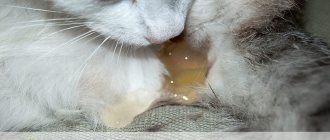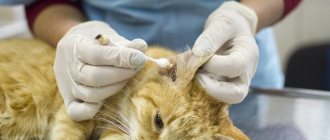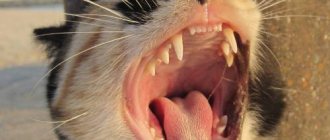7254Pavel
When owners notice that a cat has a bump on the withers, a variety of thoughts arise in their heads. In this situation, the first thing you should remember is whether your pet has recently been vaccinated.
A reaction in the form of bumps at the injection site after vaccination is a common occurrence in cats and dogs, and it does not matter how old the animal is: a year or ten. Read about the options for this complication, as well as other causes of a tumor on the withers of a cat, in this article.
© shutterstock
Is vaccination necessary?
Pets practically become members of the family. It is important that they maintain their health. However, there is always a risk of contracting dangerous diseases. Vaccinating your cat is a reliable and time-tested means of eliminating this risk.
However, in this case, temporary complications can sometimes occur. Vaccination is the infection of an animal with weakened pathogens, which it can easily cope with and develop immunity to this disease. This procedure protects not only the pet, but also its owner from serious dangers.
ATTENTION! If a cat experiences temporary complications, the caring owner is obliged to do everything possible to alleviate his suffering.
Sometimes it seems that by following a certain regime for a cat, you can guarantee the absence of infection. However, in reality it is impossible to completely avoid this danger. Even keeping a cat in an apartment does not guarantee its safety. Pathogenic microorganisms can be brought into the home, for example, on shoes.
Vaccination is necessary for the following reasons:
- Rabies is a deadly disease. Vaccination protects against it. But if this is not done, the animal may become infected and die.
- A sick pet becomes dangerous to other animals.
- A cat with rabies can infect humans with this deadly disease.
After the vaccination procedure, the risk of contracting an animal with rabies is completely eliminated.
Vaccines: when should a cat be given?
Vaccination is an important part of caring for your pet.
Vaccinations help strengthen the animal’s immunity, as well as protect it and the owner from serious diseases that can lead to the death of the furry pet.
Vaccination is also necessary before traveling and traveling, visiting exhibitions and shows where contact with other pets is possible. Vaccinations will also be required before mating to ensure the birth of healthy and active kittens. Animals, just like people, have a vaccination schedule, which every owner who wants the animal to be healthy is obliged to follow.
How is it carried out?
In order to protect a cat from rabies, the first vaccination is carried out at the age of 12 weeks or a little later. As a result, the animal develops immunity that lasts for one year. To ensure reliable protection against rabies, vaccination is required annually.
It is recommended to reuse the vaccine from the same manufacturer. It is important to pay attention to how the pet tolerates the procedure . If it responds well to the vaccine from this particular manufacturer, then it makes sense to use it regularly. In the event that problems arise with vaccinations, it makes sense to consult a veterinarian about using another option.
After the injection, quarantine occurs for 14 days. During this period, the animal develops immunity. At this time, it is necessary to ensure that your pet appears on the street as little as possible and has contact with other animals. During the time when immunity is developed, the cat’s body is weakened and very vulnerable.
ATTENTION! If the procedure is performed in a veterinary clinic, this reduces the risk of adverse effects.
It is not recommended to leave immediately after the injection. It is better to wait 20 minutes to check for an allergic reaction. In this case, specialist help can be obtained immediately.
Bump on a kitten's withers
In small kittens, swelling on the neck may appear after receiving the rabies vaccine. Kittens begin to be vaccinated at 3 months of age and then annually. Most often, such a small bump goes away within 14 days.
But there are cases when swelling serves as a signal for the development of a severe allergic reaction, which can result in anaphylactic shock. It is not recommended to leave the hospital immediately after this vaccination. It is better to observe the condition of the kitten within the walls of the veterinary hospital for half an hour.
Types of complications
After vaccination, your pet often experiences temporary complications. They can be expressed as follows:
- an allergic reaction to the injection . It can be expressed, in particular, in the form of swelling, redness, and skin rashes. In such cases, an antihistamine is additionally administered. In extremely severe cases, anaphylactic shock may occur.
- may appear under the skin at the withers in the form of a small bump. The reason may be unprofessional administration of the vaccine or the individual characteristics of the animal’s body.
- Reduced immunity during the quarantine period increases the likelihood of other diseases or the appearance of worms.
- Sometimes vaccination can contribute to the manifestations of kidney failure. This is due to the fact that the vaccine is made from cat kidney cells. Once in the body, it can cause the formation of antibodies that act on this organ. The main cause of this complication is too frequent vaccination.
When a pet suffers during vaccination, a loving owner is obliged to do everything possible to support the animal and alleviate its suffering.
If there is a lump
One of the possible complications after vaccination is the formation of a lump at the injection site. First of all, it is important to determine the cause of what happened. If you contact a specialist, he will conduct a thorough analysis, determine the diagnosis and offer appropriate treatment.
Typically, the following means can be used for this:
- taking medications;
- use of compresses;
- in rare cases, surgery may be required.
Usually this problem is solved in no more than a week.
Reasons why bruises often appear on the legs
The appearance of bruises on the legs without a blow or injury is an alarming sign indicating health problems. Most often they occur suddenly and may be accompanied by bruising. In this case, you should not delay a visit to the doctor, since if the blood vessels are in normal condition without injury, hemorrhage does not occur in the upper layers of the skin. In case of injuries, they can remain on the legs for quite a long time and this is a type of norm that does not require special treatment.
Among them may be:
- Vitamin deficiency, in which due to a lack of vitamins C, K, P, the elasticity of the walls of blood vessels decreases and their fragility increases. If you adjust the menu and replenish it with rose hips, black currants, chokeberries, then the lack of vitamins can be compensated. Most often, such bruises appear in the spring, when the manifestations of vitamin deficiency are most severe.
- Reduced strength of the connective tissue that protects the capillaries. In this case, the appearance of bruises on the legs without a contusion becomes possible with the slightest pressure. This needs to be diagnosed (which is only possible in a specialized center). If the diagnosis is established, sometimes the fragility of blood vessels can be eliminated by taking special medications.
- Lack of platelets, in other words, a blood disease in which there are problems with blood clotting. The localization of bruises is not limited to the legs alone; they also appear on other parts of the body.
- Varicose veins, which not only cause bruising, but also spider veins. The appearance of bruises in this case may be accompanied by a feeling of heaviness in the legs, swelling, and bloating of the veins. As a treatment, the doctor will prescribe you: taking special medications that increase the tone of the veins; sclerotherapy (bonding of blood vessels through subcutaneous administration of drugs); wearing special knitwear that maintains muscle and vein tone).
- Hemorrhagic vasculitis. The reason for the appearance of this disease lies in the fact that the immune system fails and the cells of the blood vessels are perceived as foreign. The IS begins to produce antibodies that destroy the walls of blood vessels. This leads to inflammation, and as a result, the appearance of hematomas.
- Yellow bruises may indicate ruptured blood vessels. This is typical for people actively involved in sports. Under heavy load, capillaries under the skin of the extremities inevitably burst. As a result, bruises appear. Therefore, if after a fitness class your legs hurt a lot and bruises appear, we recommend reducing the level of stress during training.
- The appearance of bruises on the body may be a consequence of developing diabetes, because contrary to popular belief, this disease does not only affect blood sugar levels. Diabetes causes a metabolic disorder that affects blood circulation. Bruises appear, seemingly for no apparent reason, because the vessels become more fragile and brittle, and blood clotting worsens.
- Another reason for the appearance of bruises under the knee at the back, most often is a tendon sprain, varicose veins or internal arterial thrombosis.
- Also, if bruises appear on their own, seemingly for no apparent reason, this may be a reaction to the use of analgesics, antidepressants and anti-inflammatory drugs. The fact is that the components of these drugs reduce blood viscosity, which in turn leads to the appearance of hematomas.
You should start by diagnosing the causes, for which you should visit a phlebologist to rule out problems with the blood. If many small bruises appear on the body, we are talking about a blood disease. By taking tests, the number of platelets in the blood is determined and if a deficiency is detected, appropriate treatment is prescribed. If everything is normal according to hematology, you cannot do without examining the blood vessels to find out why bruises often appear on the body and legs: on the foot, on the inside of the thigh, on the knees, on the calves.
As preventive measures, it is advisable (even in the absence of problems with blood vessels) to wear comfortable shoes, dose physical activity, avoiding stagnation on the one hand, but also without straining it excessively, on the other, adjusting the diet. At the first signs of varicose veins, it would be a good idea to take special medications that strengthen the walls of blood vessels, but only a specialist can say about the advisability of taking them, as well as recommend a specific drug and its dosage. And then the problem that women often develop bruises on their legs for no reason will not bother you.
At the Antireflux phlebological center, our specialists will help you identify the true causes of bruises on your legs and body. After conducting the necessary tests and diagnostic studies, the necessary medications and treatment regimen will be selected according to the cause of the bruises.
Watch our video about why bruises can form for no reason:
What does the appearance of a seal mean?
A caring owner should think about how to protect their pet from the danger of contracting rabies. However, sometimes after an injection a subcutaneous lump may appear, which causes concern about the cat’s health.
The appearance of a lump cannot be a reason for panic. This reaction to an injection is possible for several reasons:
- if the animal has an allergic reaction to the administered drug;
- when using a low-quality vaccine.
In most cases, the lump under the skin goes away without the need to take any measures . In a week, no trace of her will be visible. Usually, after an injection, the solution concentrates in one place, and within a few days it disperses throughout the body. The easiest way to take care of an animal in this situation is to help this process.
This can be done by applying a compress to the injection site (on the back of the neck or between the shoulder blades). To do this, take gauze, fold it in several layers and moisten it in an alcohol solution. The compress is applied to the area of compaction for 10 minutes. The procedure must be repeated twice during the day. After its completion, the sore spot is carefully wiped.
IMPORTANT! If the animal tends to scratch the injection site, the use of antihistamines to reduce itching may help.
However, in rare cases, the appearance of a lump indicates more serious things:
- The appearance of a purulent abscess . The inflammatory process occurs as a result of the penetration of pathogenic microorganisms into the wound after an injection. In this situation, it is necessary to contact a specialist who will open the abscess.
- In rare cases, compaction is one of the signs of sarcoma. One of the signs of such a situation is the long time during which it remains with the cat. In this case, palpation does not cause pain, and the seal looks hard to the touch.
The risk of such a disease is associated with the presence of aluminum hydroxide in the composition of the drug. It takes a relatively long time for a tumor to form: from several months to many years. It always appears at the injection site and is characterized by a high growth rate and the presence of clearly palpable boundaries. Only adults are at risk of developing sarcoma. Such tumors almost never occur in a kitten or an old animal.
If a lump occurs, you can wait a few days until it resolves without doing anything . It is advisable to contact a veterinarian, but if there are no warning signs, you can act on your own.
The situation requires the mandatory attention of a specialist in the following cases:
- The lump remains unchanged for a significant period of time.
- In a situation where a wound has formed at the injection site (on the withers or between the shoulder blades), and pus comes out of it.
- An animal's restless behavior after vaccination is a sufficient reason to invite a veterinarian.
- An alarming symptom is the presence of elevated temperature.
- When hair loss occurs.
- If an ulcer forms at the injection site or throughout the body.
When bumps appear after injections, the doctor must decide what to do in the listed cases. A caring owner must monitor the situation and take action in accordance with the cat’s health condition.
Causes of swelling after self-vaccination
If the cat owner purchased the vaccine and gave the injection himself, then the reasons for the appearance of the lump mentioned above are added to the following:
- The cat is not prepared for immunization: the worms and fleas were not driven away and an allergic reaction developed.
- Spoiled vaccine: transportation and storage rules were violated. The owner purchased the biological product in hot weather and delivered it home without a thermos bag. Instead of the refrigerator, I put the vaccine on the windowsill. I diluted the biological product and gave the injection a few hours or days later. I bought the vaccine for future use. When it was necessary to vaccinate a year later, it turned out that the expiration date had expired, and it was a pity to throw it away. Violations of transportation rules from the manufacturer to the pharmacy cannot be ruled out.
- Inept vaccination: after the biological product has been taken out of the refrigerator and diluted, it is necessary to warm the liquid in your hand. They didn’t read the instructions carefully, and instead of subcutaneous administration they injected it intramuscularly. We treated the injection site with an antiseptic, although the instructions prohibit this. Or not processed, if the manufacturer insists. The pet was poorly secured: it twitched and the liquid got into the wrong place.
If a lump appears at the site of the vaccination injection, your pet should be observed. If the tumor does not resolve for more than two weeks, or an inflammatory process develops, contact a veterinarian.
Thermal container with refrigerant for transporting vaccines
If you are vaccinated at the clinic, you should not leave immediately; you should wait 15-20 minutes. If an allergic reaction develops, the veterinarian will stop it. This is not possible at home, so you need to have antihistamines on hand - Suprastin or analogues.
Prevention
In order to minimize the risk of a cat developing a bump after vaccination or other complications, you need to adhere to the following rules:
- In order to get vaccinated, you need to contact a specialist and carry out this procedure in a veterinary clinic.
- When choosing a vaccine, be sure to check its expiration date. If it is not suitable, such a drug cannot be used.
- Although vaccination must be carried out at a certain time, you need to ensure that the animal is not sick at this time and does not have worms.
- When carrying out, it is necessary to remember that immunity exists for a limited period of time. In order for an animal to be safe from rabies infection, it is necessary to vaccinate regularly and do it at a certain time.
- After completing the procedure and during quarantine, you should not wash your pet or expose it to hypothermia.
- It is necessary to plan the procedure in such a way that it is not carried out for kittens during teething, or for adult cats during pregnancy.
After the animal has received the vaccine, it is important to monitor its condition and pay attention to any problems that arise (a wound appeared at the injection site, a lump formed, the cat was vomiting, or others). It is advisable to consult a veterinarian in such situations.
Regular vaccination will protect your pet from the risk of contracting rabies. However, the procedure can sometimes cause complications in the animal. In this case, the owner must take the necessary measures to help his cat.










